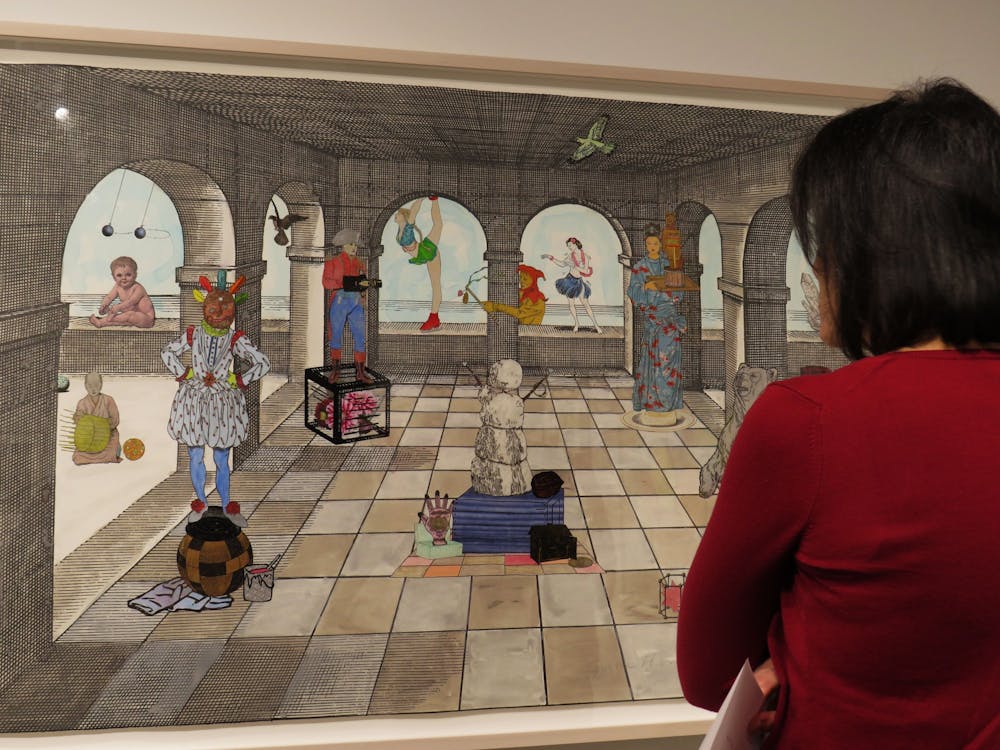Kauffman Gallery hosted renowned art curator, Esther Adler, to Pace Prints exhibit on Feb. 13.
Esther Adler is the Associate curator of drawing and prints at the Museum of Modern Arts (MoMA) in New York. She visited the university in conjunction with New York City’s Pace Prints exhibit. She told attendees about her background and gave advice on pursuing a career in art.
Art curators create, manage and present art exhibits, galleries and collections in museums. These exhibits can take anywhere from two to five years to create and open for the public, Adler said.
While in the gallery, Adler chose three of her favorite prints and explained each one during the lecture. 'A Room of One's Own (Golden Dollhouse)' by Jane Hammond was the first print.
James Siena created the second print, called 'Sagging Grid.' Adler shared that this piece appealed to her the most. The artist created the triangular grid by pressing the shapes into inked paper. This technique is known as a reduction linocut.
Arturo Herrera created the final print called 'Giuseppe.' The piece is a textured collage of various different media, including printed photos and paint, with red felt that dominated the middle of the print.
In Huber Art Center, Adler shared her experiences with her education and job as an associate curator to art students. Adler received a Bachelor’s of Arts in Art History from Brandeis University in Boston, Massachusetts. Adler then attended graduate school at the University of Maryland where she received her Master of Arts focused on Josef Albers.
Adler emphasized the importance of internships. She worked at several different museums, such as the Hirshhorn Museum in Washington, D.C. and the Museum of Fine Arts (MFA) in Boston, Massachusetts over summer breaks to gain experience to add to her resume.
"The biggest struggle for me always is time. There is always more to read, always more to look for, sometimes you travel to an archive and only have three days," Adler said.
"You have to prioritize. What are you going to prioritize? What if you don't find the piece you're looking for? What if you find something you didn't know existed, how does that change the scope of the project?" she added.
MoMA displays roughly 3-5% of its art at any given time. Adler explained the permanent collection is what is put on display and sold to collectors and other museums. The special collection is borrowed art from other museums that is put on display for special galleries.
Charles White is an African American artist who depicted black subjects through his artwork before his death in 1979. Adler's interest in White came from the 2013 "Now Dig This! Art and Black Los Angeles 1960-1980" exhibition by curator Kellie Jones at the Hammer Museum in Los Angeles, California.
Adler wrote the book "Charles White: Black Pope" in 2017, and in 2018 co-edited the catalog, "Charles White: A Retrospective." The exhibition displayed works from several black artists from the '60s and '70s, including works from Betye Saar. It is currently at the MoMA Public School 1 (PS1.)
Charles White’s dedication to his artwork is important to modern and contemporary practice that is left out of art history, Adler said.
The exhibition introduced Adler to Saar, who she wrote a book about called, "Betye Saar: Black Girl's Window" with co-author Christophe Cherix.
Adler's current projects include an exhibition of self-taught artist, Joseph Yoakum, who created landscape pieces during the 60s. Researchers have not yet explored Yoakum's background and his art.
"What has been missing is a real look at his work as it relates to other work in the 20th century, and really to life in the 20th century," Adler said.
Adler hopes to raise more awareness of the artist by opening and hosting the exhibition in Chicago, Yoakum's birthplace. The exhibition will open at the Art Institute of Chicago in January 2021, will come to MoMA in the summer of 2021 and end at Menil Collection in Houston, Texas.
The Pace Prints exhibit is open until Feb 26. The gallery hours are Monday through Thursday from 9 a.m.-3 p.m., Wednesday evenings from 6:30 p.m.-8:30 p.m., and Friday 9 a.m.-1 p.m.





The Slate welcomes thoughtful discussion on all of our stories, but please keep comments civil and on-topic. Read our full guidelines here.